Research on Hierarchical Control Strategy of ESS in Distribution Based on GA-SVR Wind Power Forecasting
Abstract
:1. Introduction
2. Short-Term Forecasting of Wind Power Based on Improved GA-SVR
2.1. Support Vector Regression
2.2. Parameter Optimization Method Based on Improved Genetic Algorithm
- (1)
- In the first training model, training set 1 is used as the GA-SVR training sample set.
- (2)
- Training set 2 is used as a cross-validation set to calculate fitness.
- (3)
- In the second training model, training set 2 is taken as the new training sample set.
- (4)
- Training set 3 is used as a cross-validation set to calculate fitness.
- (5)
- In the mth training model, training set m is taken as the training sample set, and training set 1 is used as the cross-validation set to calculate the adaptive set.

3. Hybrid Energy Storage Capacity Allocation Strategy
4. Hierarchical Control Strategy for Hybrid Energy Storage System
4.1. Upper Limiting Control of Hybrid Energy Storage System
4.2. Lower Layer Coordinated Control of Hybrid Energy Storage System
- (1)
- When HESS works on State 1:
- (2)
- When HESS works on State 3:
- (3)
- When HESS works at 14:00 in State:
- (4)
- When HESS works on State 29:
5. Example Simulation
5.1. Simulation Analysis of Short-Term Prediction of Wind Power
5.2. Simulation Analysis of Hierarchical Control of Hybrid Energy Storage System
5.3. Simulation Analysis of Wind Power Fluctuation Stabilization in Hybrid Energy Storage System
6. Conclusions
Author Contributions
Funding
Data Availability Statement
Conflicts of Interest
Appendix A
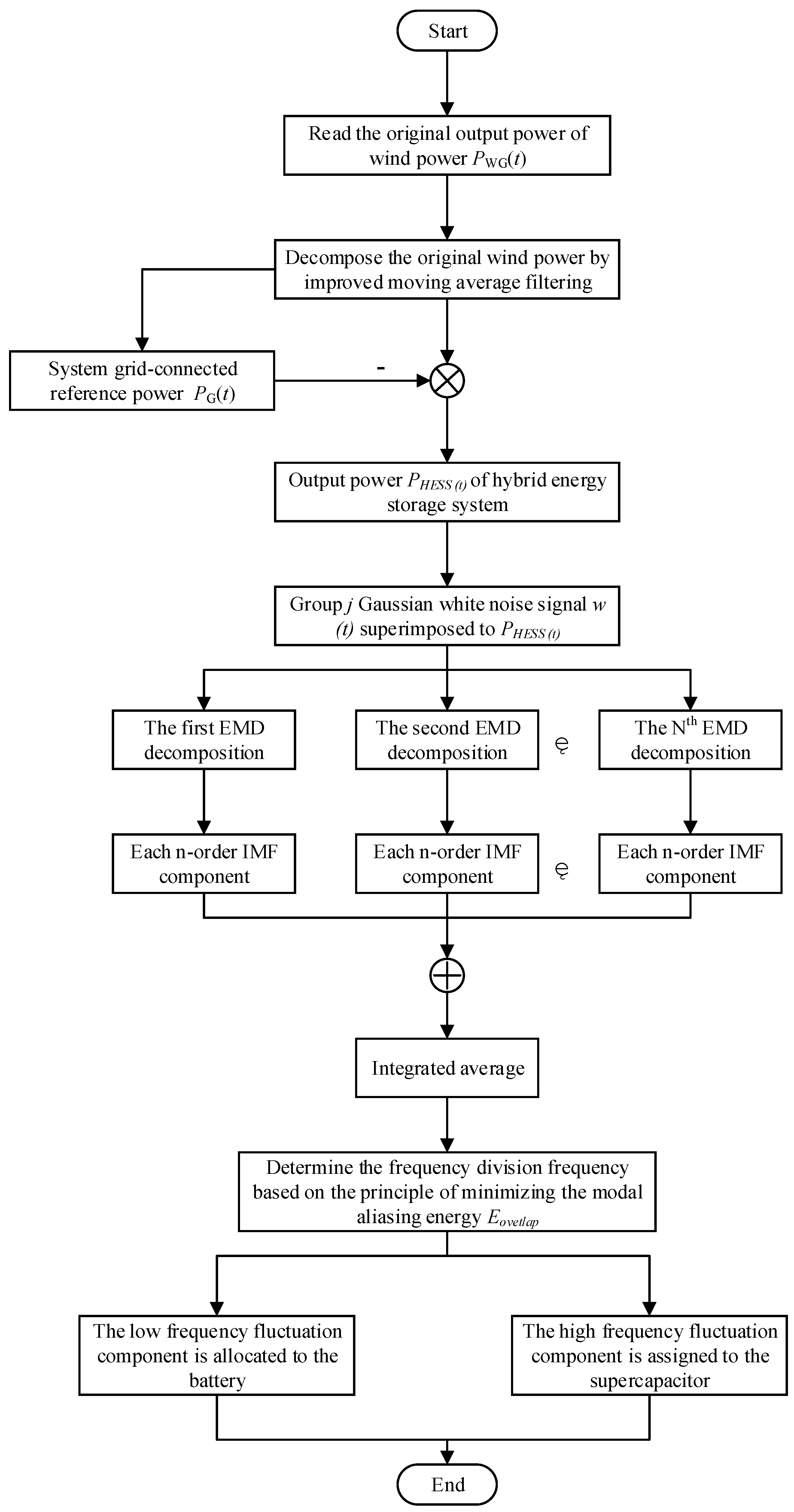
Appendix B
| Working State | SOCB | Energy Storage State | SOCC | Energy Storage State | ||||||
|---|---|---|---|---|---|---|---|---|---|---|
| <0.15 | 0.15~0.85 | >0.85 | + | − | <0.1 | 0.1~0.9 | >0.9 | + | − | |
| State 1 | √ | √ | √ | √ | ||||||
| State 2 | √ | √ | √ | √ | ||||||
| State 3 | √ | √ | √ | √ | ||||||
| State 4 | √ | √ | √ | √ | ||||||
| State 5 | √ | √ | √ | √ | ||||||
| State 6 | √ | √ | √ | √ | ||||||
| State 7 | √ | √ | √ | √ | ||||||
| State 8 | √ | √ | √ | √ | ||||||
| State 9 | √ | √ | √ | √ | ||||||
| State 10 | √ | √ | √ | √ | ||||||
| State 11 | √ | √ | √ | √ | ||||||
| State 12 | √ | √ | √ | √ | ||||||
| State 13 | √ | √ | √ | √ | ||||||
| State 14 | √ | √ | √ | √ | ||||||
| State 15 | √ | √ | √ | √ | ||||||
| State 16 | √ | √ | √ | √ | ||||||
| State 17 | √ | √ | √ | √ | ||||||
| State 18 | √ | √ | √ | √ | ||||||
| State 19 | √ | √ | √ | √ | ||||||
| State 20 | √ | √ | √ | √ | ||||||
| State 21 | √ | √ | √ | √ | ||||||
| State 22 | √ | √ | √ | √ | ||||||
| State 23 | √ | √ | √ | √ | ||||||
| State 24 | √ | √ | √ | √ | ||||||
| State 25 | √ | √ | √ | √ | ||||||
| State 26 | √ | √ | √ | √ | ||||||
| State 27 | √ | √ | √ | √ | ||||||
| State 28 | √ | √ | √ | √ | ||||||
| State 29 | √ | √ | √ | √ | ||||||
| State 30 | √ | √ | √ | √ | ||||||
| State 31 | √ | √ | √ | √ | ||||||
| State 32 | √ | √ | √ | √ | ||||||
| State 33 | √ | √ | √ | √ | ||||||
| State 34 | √ | √ | √ | √ | ||||||
| State 35 | √ | √ | √ | √ | ||||||
| State 36 | √ | √ | √ | √ | ||||||
Appendix C
| Working State of Hybrid Energy Storage System | PB_ref(t) | PC_ref(t) | Working State of Hybrid Energy Storage System | PB_ref(t) | PC_ref(t) |
|---|---|---|---|---|---|
| State 1 | P2 | PC1 | State 19 | P2 | PC1 |
| State 2 | P2 | 0 | State 20 | P3 | 0 |
| State 3 | PB_max | PHESS-PB_max | State 21 | P2 | PC1 |
| State 4 | PB_max | PHESS-PB_max | State 22 | P2 | PC1 |
| State 5 | P3 | 0 | State 23 | P3 | 0 |
| State 6 | P2 | PC1 | State 24 | P2 | PC1 |
| State 7 | 0 | PC1 | State 25 | 0 | PHESS |
| State 8 | 0 | 0 | State 26 | 0 | 0 |
| State 9 | 0 | PHESS | State 27 | 0 | PHESS |
| State 10 | 0 | PHESS | State 28 | 0 | PHESS |
| State 11 | 0 | 0 | State 29 | 0 | 0 |
| State 12 | 0 | PHESS | State 30 | 0 | PC1 |
| State 13 | P2 | PC1 | State 31 | P2 | PC1 |
| State 14 | P3 | 0 | State 32 | P3 | 0 |
| State 15 | P2 | PC1 | State 33 | −PB_max | PHESS + PB_max |
| State 16 | P2 | PC1 | State 34 | −PB_max | PHESS + PB_max |
| State 17 | P3 | 0 | State 35 | P2 | 0 |
| State 18 | P2 | PC1 | State 36 | P2 | PC1 |
References
- Nathwani, J.; Kammen, D.M. Affordable Energy for Humanity: A Global Movement to Support Universal Clean Energy Access. Proc. IEEE 2019, 107, 1780–1789. [Google Scholar] [CrossRef]
- Xue, Y.; Lei, X.; Xue, F.; Yu, C.; Dong, Z.Y.; Wen, F.S.; Ju, P. A Review on Impacts of Wind Power Uncertainties on Power Systems. Proc. CSEE 2014, 34, 5029–5040. [Google Scholar]
- Sun, R.; Zhang, T.; He, Q.; Xu, H. Review on Key Technologies and Applications in Wind Power Forecasting. High Volt. Eng. 2021, 47, 1129–1143. [Google Scholar]
- Wang, H.L.; Jiang, T.; Wu, Y.L.; Wang, N.S. Analysis on Distribution Network Power Quality Considering New Energy Grid-connected Power Generation. New Energy Power Control. Technol. 2021, 43, 20–23. [Google Scholar]
- Li, H.Z.; Zhang, Y.; Sun, W.Q. Wind power fluctuation smoothing strategy with generalized energy storage under wavelet packet decomposition. Power Syst. Technol. 2020, 44, 4495–4504. [Google Scholar]
- Cao, M.; Xu, Q.; Qin, X.; Cai, J. Battery energy storage sizing based on a model predictive control strategy with operational constraints to smooth the wind power. Int. J. Electr. Power Energy Syst. 2020, 115, 105471. [Google Scholar] [CrossRef]
- Li, P.Q.; Li, W.Y.; Tang, J.; Li, H.; Wang, J. Method of Hybrid Energy Storage to Smooth the Fluctuations for Wind Power Based on. Proc. CSU-EPSA 2017, 29, 20–27. [Google Scholar]
- Qian, F.; Zhang, X.D.; Liu, J.L.; Fu, C. Control method of wind power grid connection based on variational mode decomposition technology and hybrid energy storage strategy. Eng. J. Wuhan Univ. 2021, 54, 354–360+374. [Google Scholar]
- Ding, M.; Wu, J.; Zhu, C.; Zhao, B.; Chen, Z.; Luo, Y. A Real-time Smoothing Control Strategy With SOC Adjustment Function of Storage Systems. Proc. CSEE 2013, 33, 22–29. [Google Scholar]
- Jiang, Q.; Hong, H. Wavelet-Based Capacity Configuration and Coordinated Control of Hybrid Energy Storage System for Smoothing Out Wind Power Fluctuations. IEEE Trans. Power Syst. 2013, 28, 1363–1372. [Google Scholar] [CrossRef]
- Jiao, D.D.; Chen, H.; Fang, Y. Control strategy of hybrid energy storage for suppressing fluctuation of wind power output based on variational mode decomposition. Electr. Meas. Instrum. 2021, 58, 14–19+30. [Google Scholar]
- Li, Y.N.; Wang, Q.; Song, W. Variational mode decomposition and fuzzy control strategy of hybrid energy storage for smoothing wind power outputs. Power Syst. Prot. Control. 2019, 47, 58–65. [Google Scholar]
- Zhang, X.; Zhang, F.; Liang, J.; Zhang, L.; Han, X.S.; Yang, L.B. An Optimal Look-ahead Control Strategy for Hybrid Energy Storage System Based on Wind Power Prediction. Autom. Electr. Power Syst. 2015, 39, 58–65. [Google Scholar]
- Yan, H.; Li, X.J.; Ma, X.F.; Hui, D. Wind Power Output Schedule Tracking Control Method of Energy Storage System Based on Ultra-Short Term Wind Power Prediction. Power Syst. Technol. 2015, 39, 432–439. [Google Scholar]
- Yuan, Y.W. Research on Hybrid Energy Storage Control Strategy Based on Ultra-short-time Wind Power Prediction; North China Electric Power University: Beijing, China, 2017. [Google Scholar]
- Li, B.; Deng, Y.X.; Chen, B. Advanced Rolling Optimization Control Strategy for Wind Storage System With Enhanced Ultra-short-term Wind Power Prediction. Power Syst. Technol. 2021, 45, 2280–2287. [Google Scholar]
- Zhang, Y.; Han, P.; Wang, D.F.; Wang, S. Short-term prediction of wind speed for wind farm based on variational mode decomposition and LSSVM model. Acta Energ. Sol. Sin. 2018, 39, 194–202. [Google Scholar]
- Sun, Y.; Zhang, G.; Tang, X.; Jia, D.; Cao, Z. Research on MPC and daul energy storage control strategies with wind power fluctuation mitigation. Trans. China Electrotech. Soc. 2019, 34, 571–578. [Google Scholar]
- Wu, J.; Ding, M. Wind power fluctuation smoothing strategy of hybrid energy storage system using self-adaptive wavelet packet decomposition. Autom. Electr. Power Syst. 2017, 41, 7–12. [Google Scholar]
- Yan, Y.; Zhang, C.; Li, K.; Tian, C.; Wang, F. An active control strategy for composited energy storage with compressed air energy storage in micro-grid. Trans. China Electrotech. Soc. 2017, 32, 231–240. [Google Scholar]
- Han, T.W.; Chen, X.; Liu, Q.X. Short-Term Load Forecasting for Distribution Network in The Presence of TOU Price Based on Long-Short-Term Memory Network. J. Northeast. Electr. Power Univ. 2020, 40, 19–28. [Google Scholar]
- Zhao, Q.; Chen, F.F.; Gan, L. Wind power prediction based on support vector machine trained by improved particle swarm optimization. Electr. Eng. 2020, 21, 12–16. [Google Scholar]
- Cong, Y.; Li, X.F.; Yuan, S. A Multi-Periods Active Power Dispatch Method for Wind Farms Based on Improved GA Algorithm. Power Syst. Clean Energy 2021, 38, 107–114. [Google Scholar]
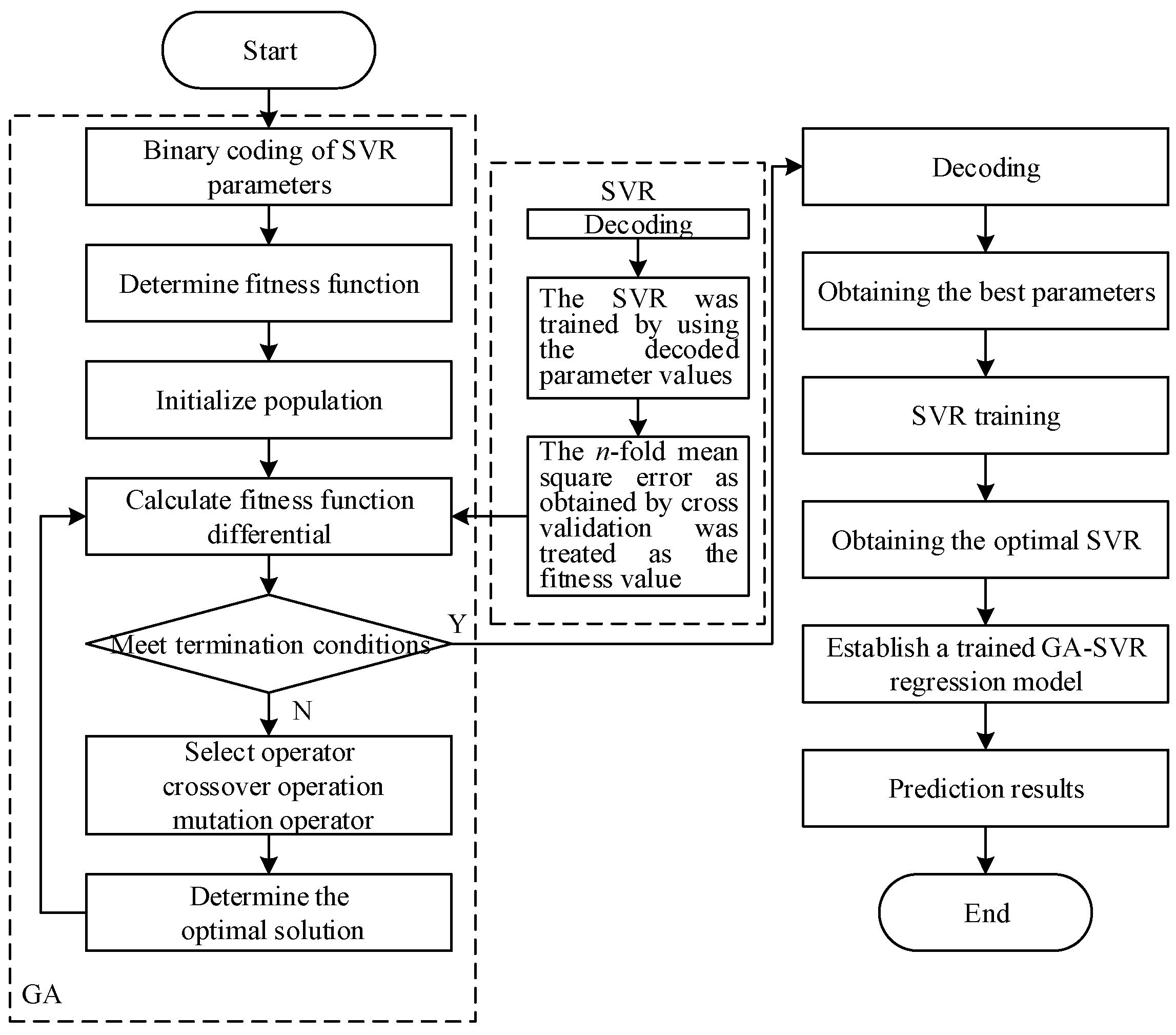
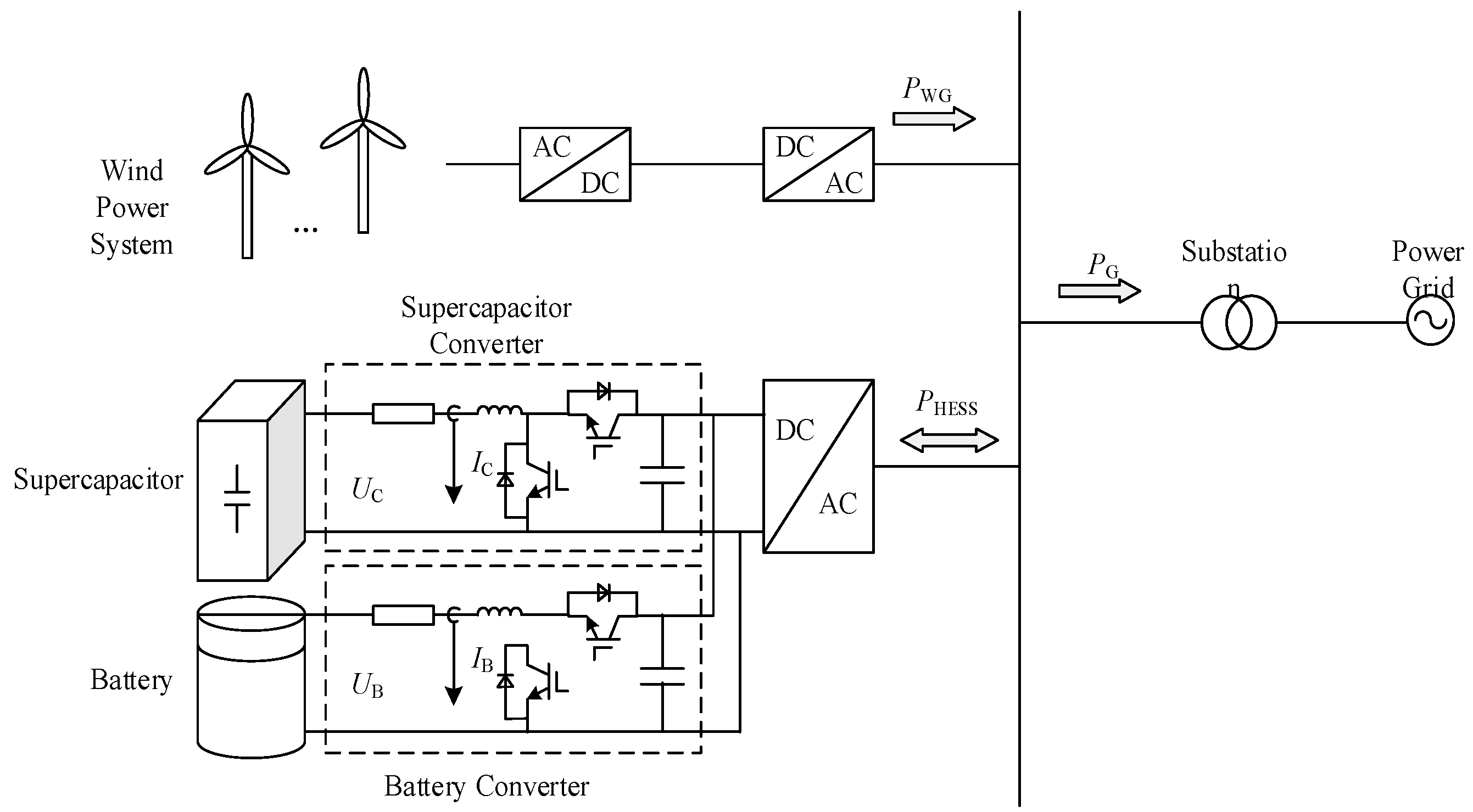

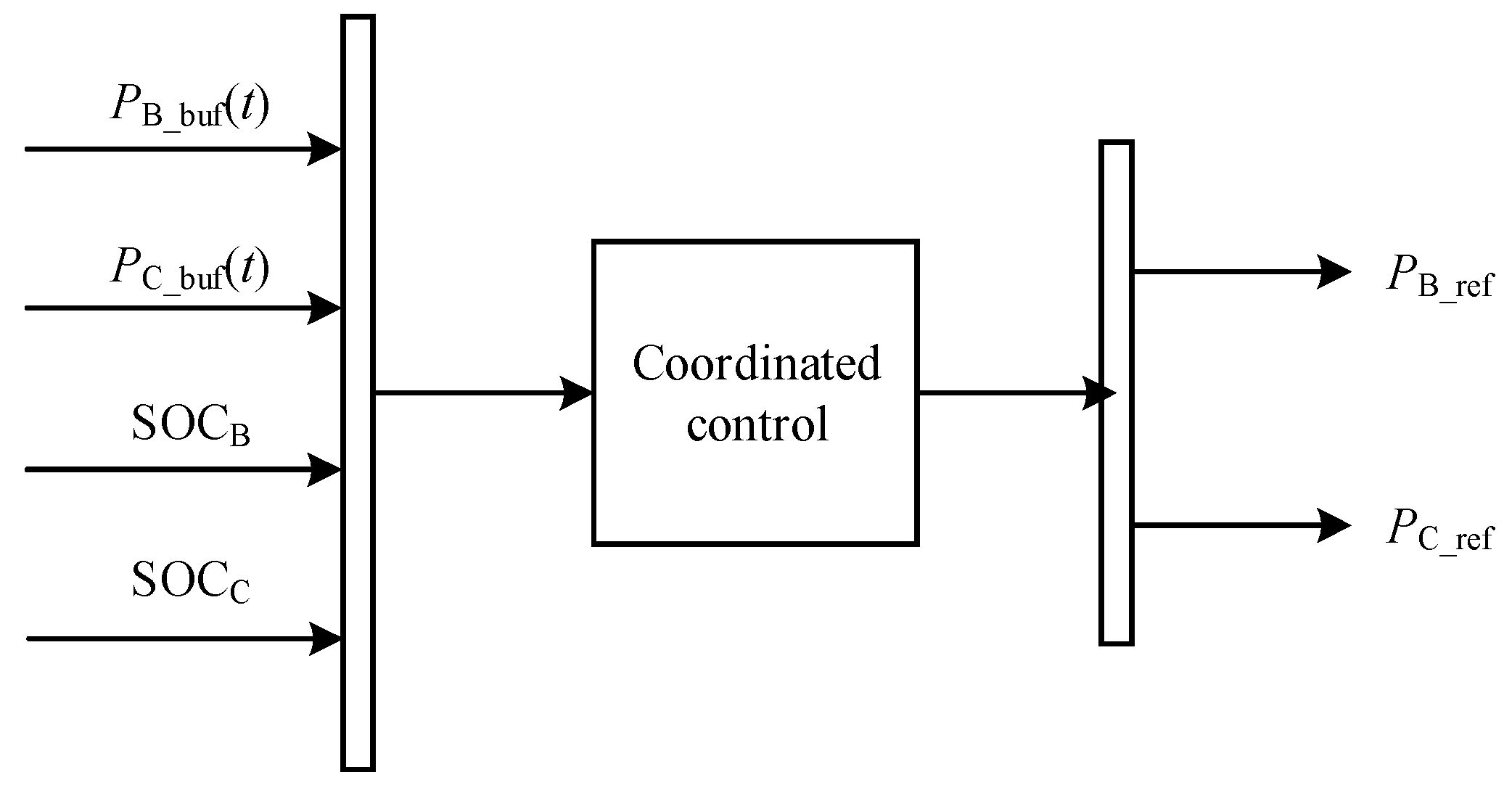
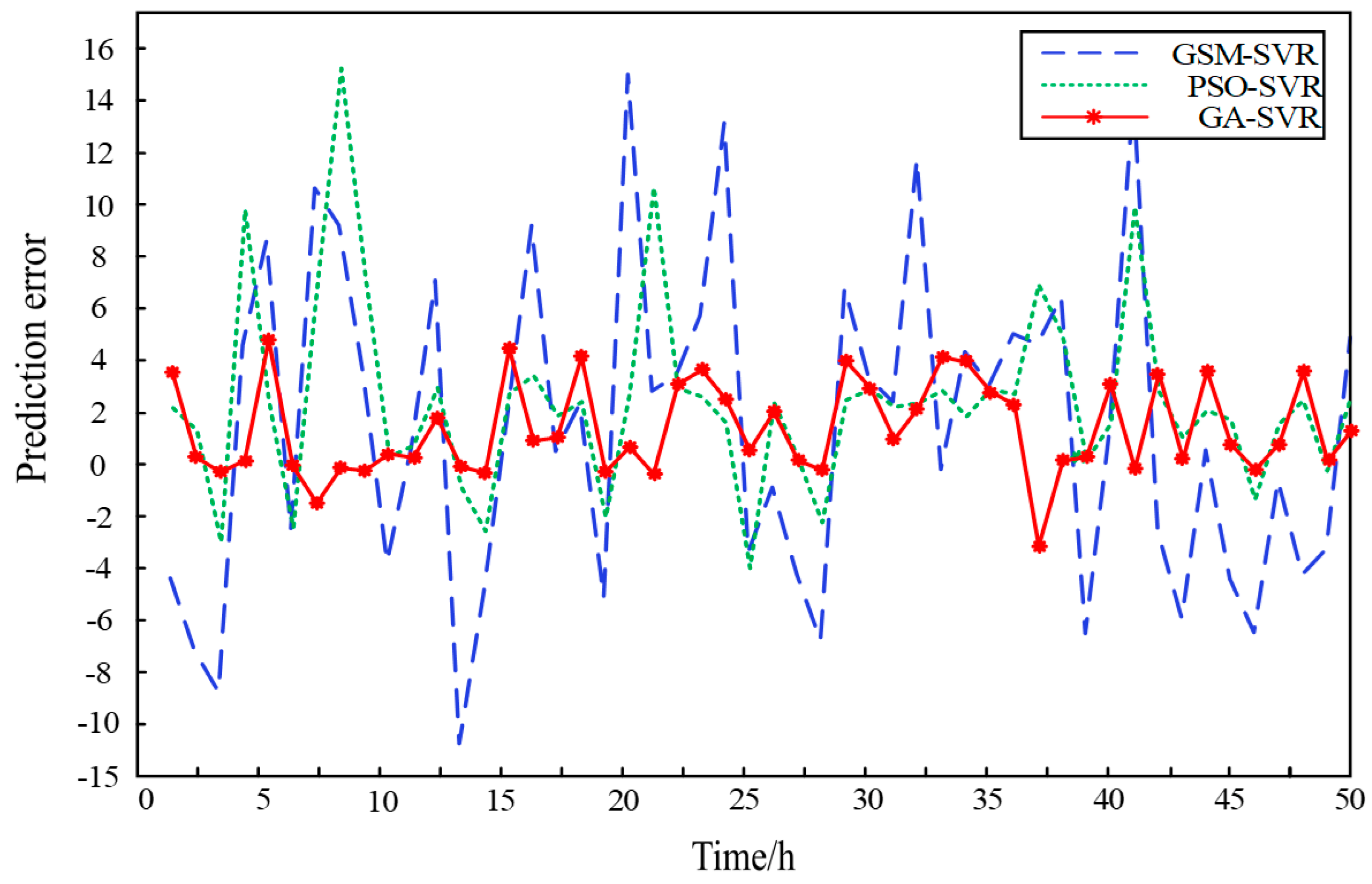
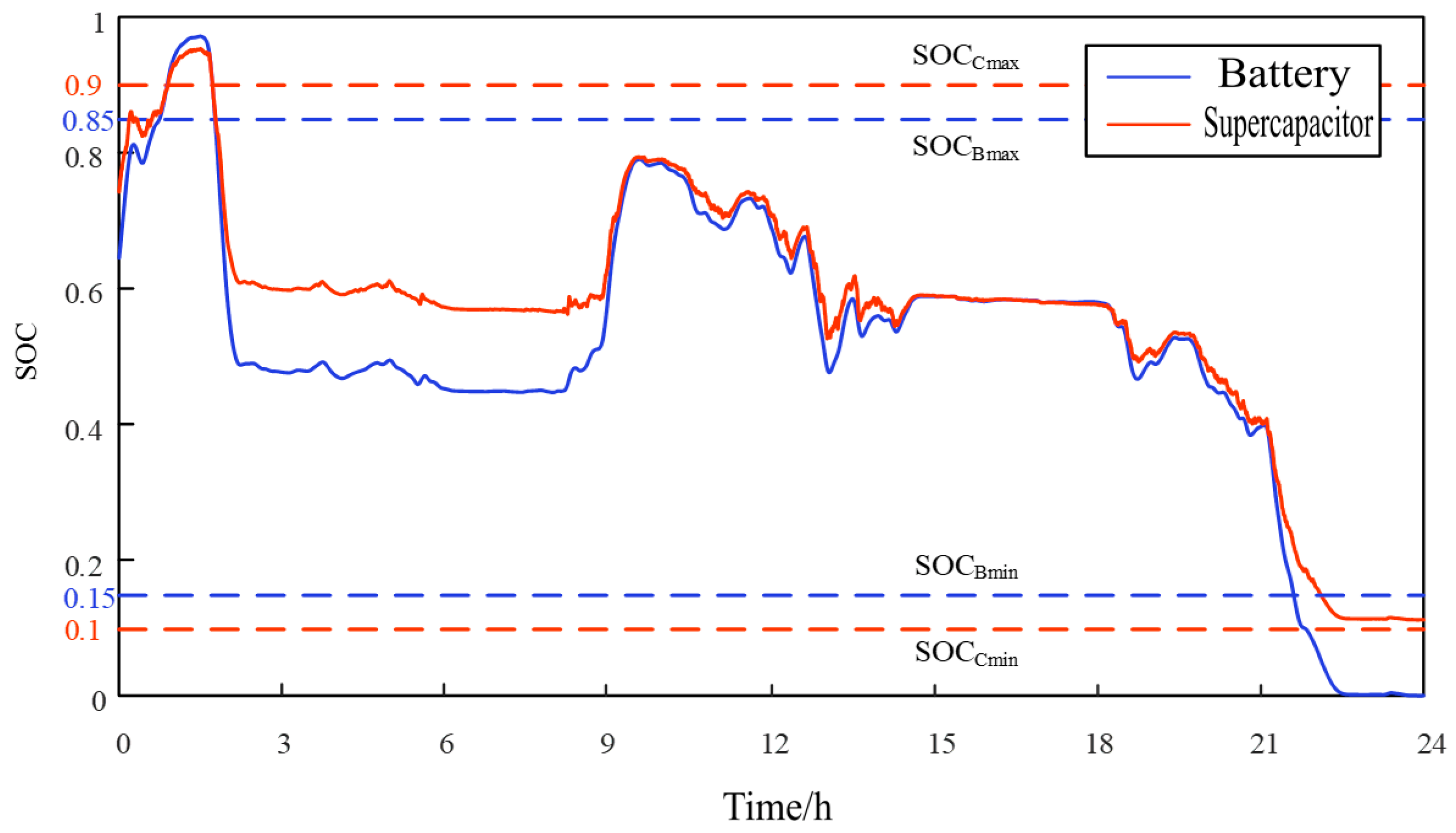

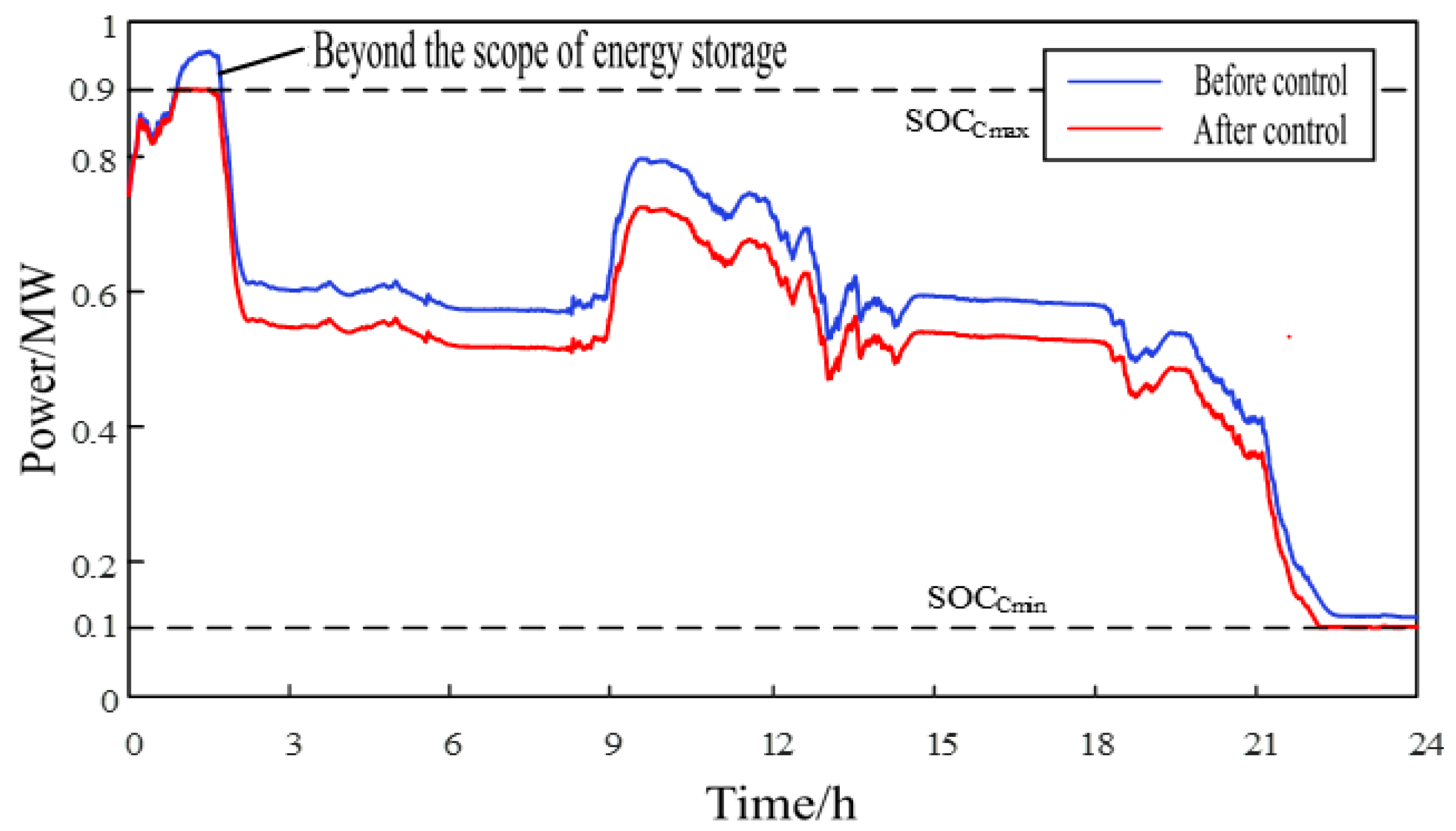
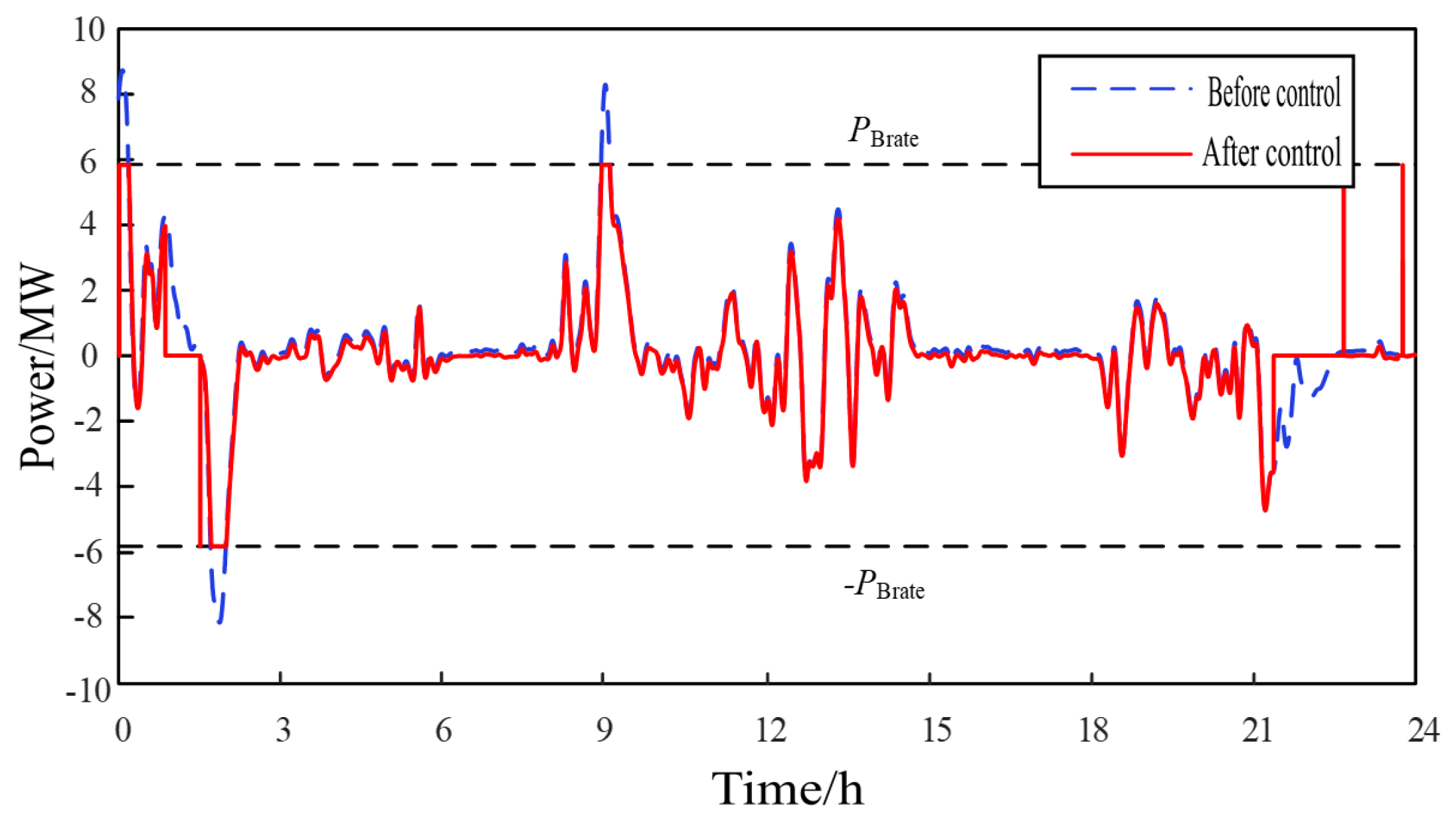
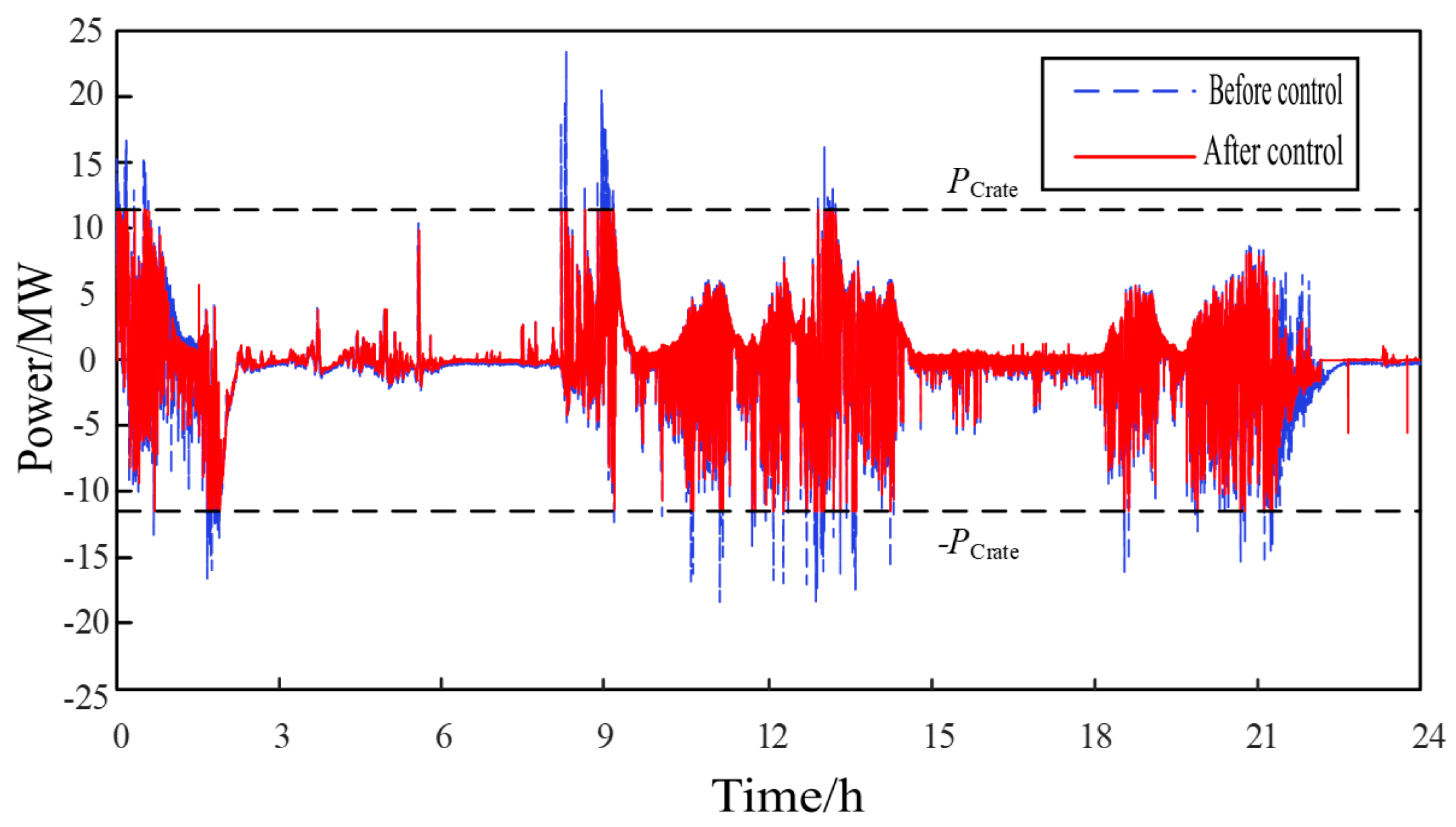
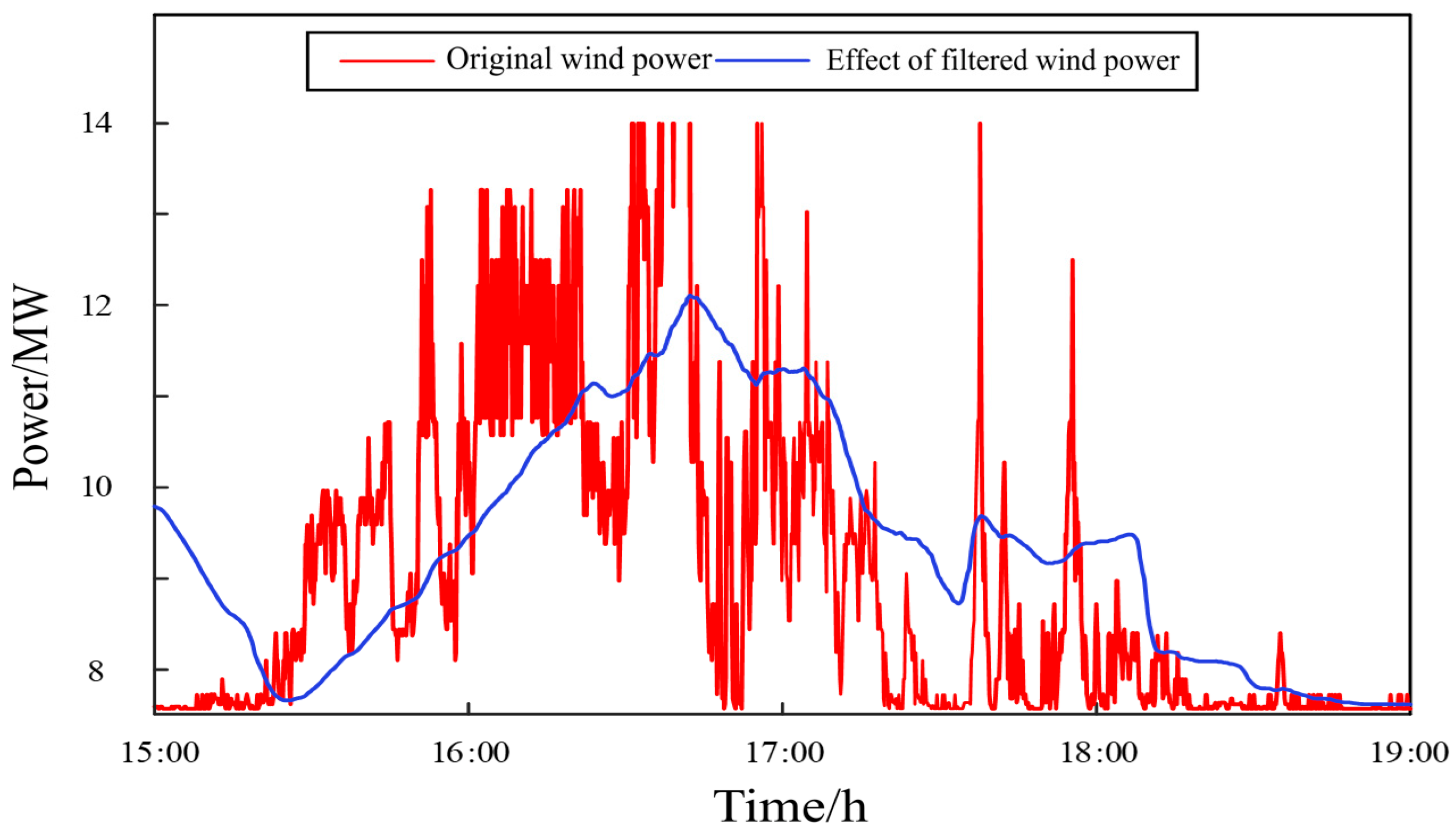
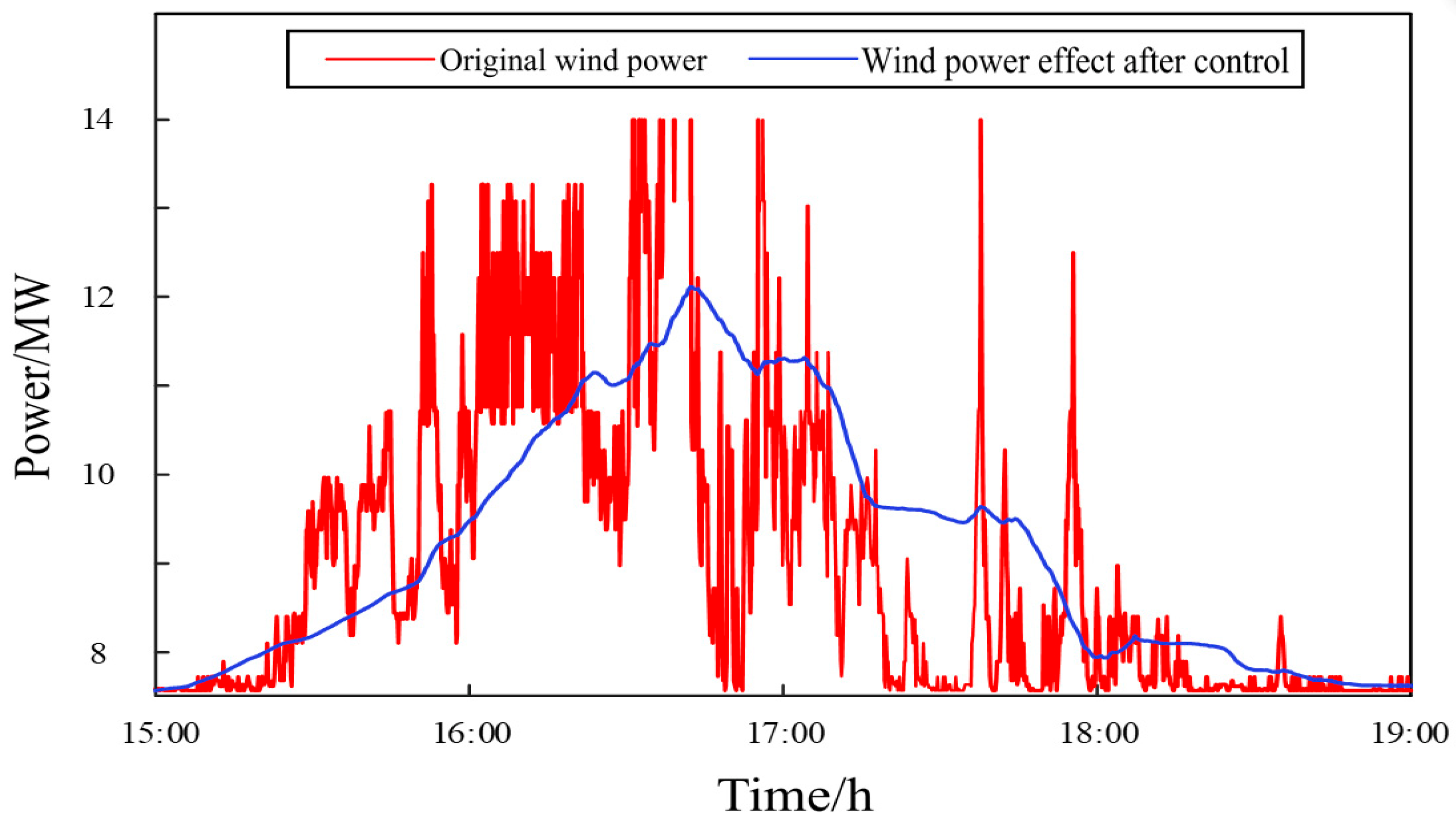
| Prediction Model | MAE/MW | RMSE/MW | Duration/s |
|---|---|---|---|
| GSM-SVR | 31.5901 | 41.6488 | 146 |
| PSO-SVR | 12.8498 | 16.1923 | 90 |
| GA-SVR | 9.6311 | 14.7435 | 45 |
| Improved GA-SVR | 9.6311 | 14.7435 | 27 |
| Index | Grid-Connected Output | SH | Td/min |
|---|---|---|---|
| Accumulator battery | Grid-connected output without hierarchical control | 0.8571 | 218.5167 |
| Grid-connected output after hierarchical control | 1 | 0 | |
| Supercapacitor | Grid-connected output without hierarchical control | 0.9655 | 52.7333 |
| Grid-connected output after hierarchical control | 1 | 0 |
Disclaimer/Publisher’s Note: The statements, opinions and data contained in all publications are solely those of the individual author(s) and contributor(s) and not of MDPI and/or the editor(s). MDPI and/or the editor(s) disclaim responsibility for any injury to people or property resulting from any ideas, methods, instructions or products referred to in the content. |
© 2023 by the authors. Licensee MDPI, Basel, Switzerland. This article is an open access article distributed under the terms and conditions of the Creative Commons Attribution (CC BY) license (https://creativecommons.org/licenses/by/4.0/).
Share and Cite
Yu, L.; Meng, G.; Pau, G.; Wu, Y.; Tang, Y. Research on Hierarchical Control Strategy of ESS in Distribution Based on GA-SVR Wind Power Forecasting. Energies 2023, 16, 2079. https://doi.org/10.3390/en16042079
Yu L, Meng G, Pau G, Wu Y, Tang Y. Research on Hierarchical Control Strategy of ESS in Distribution Based on GA-SVR Wind Power Forecasting. Energies. 2023; 16(4):2079. https://doi.org/10.3390/en16042079
Chicago/Turabian StyleYu, Linlin, Gaojun Meng, Giovanni Pau, Yao Wu, and Yun Tang. 2023. "Research on Hierarchical Control Strategy of ESS in Distribution Based on GA-SVR Wind Power Forecasting" Energies 16, no. 4: 2079. https://doi.org/10.3390/en16042079
APA StyleYu, L., Meng, G., Pau, G., Wu, Y., & Tang, Y. (2023). Research on Hierarchical Control Strategy of ESS in Distribution Based on GA-SVR Wind Power Forecasting. Energies, 16(4), 2079. https://doi.org/10.3390/en16042079







